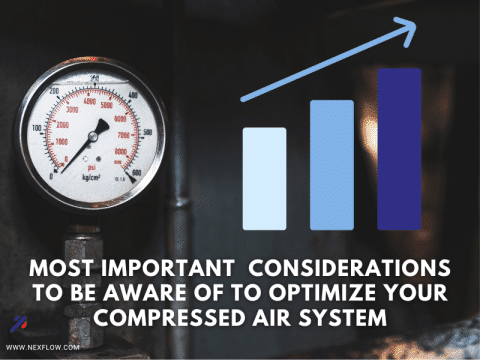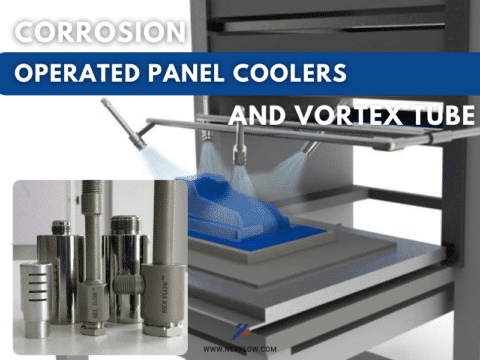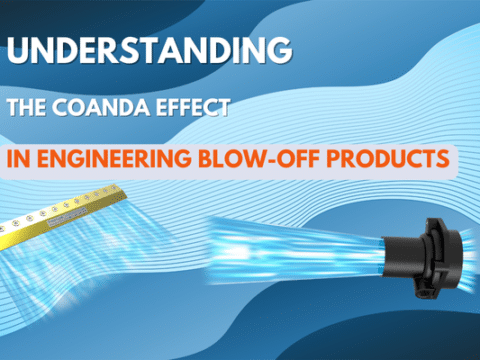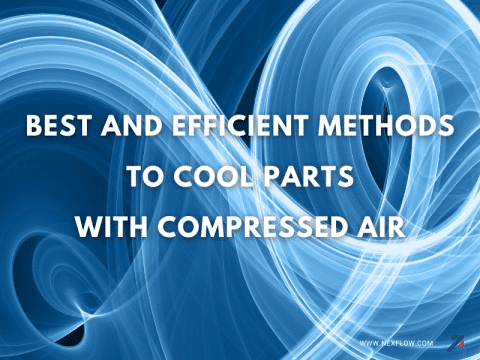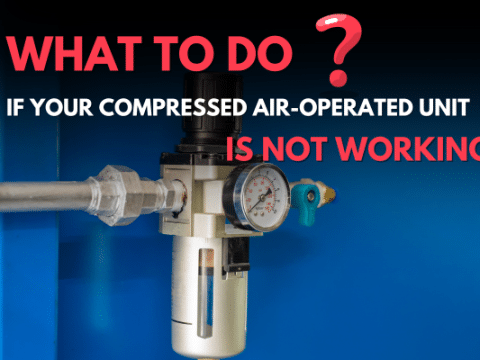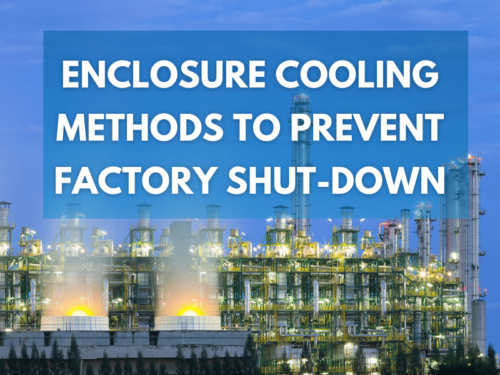
In modern industrial plants, electronic equipment is used for motor control, and most of not all machines are controlled by PLC’s. The high heat dissipation from electronic equipment exposes control systems to elevated temperatures that make them susceptible to malfunction if too hot, creating unpredictable behavior or failure that could lead to a plant shut-down.
Electrical enclosure temperatures are should be kept well below 106 ºF (41 ºC) to limit the possibility of severe damage to equipment. The heat load from electronic equipment limits the practical use of natural ventilation to cool the electrical enclosures resulting in the adoption of alternate methods.
Fans with Filters
The simplest and often lowest cost solution is to use fans to remove waste heat by circulating ambient air throughout the enclosure. This works provided the ambient air temperature is moderate if the enclosures are well shaded, and when the internal heat generated is low. Filters must be used to keep out dust and debris from the factory atmosphere and need to be cleaned and/or replaced regularly depending on the nature of the plant environment. Normally the cooler air is blown into the bottom of the enclosure, and exits “hot” at the highest point of the control panel. Fans must be sized to provide sufficient airflow to remove the heat generated by the electrical controls.
Again, the use is limited to electrical enclosures with relatively low heat loads, in shaded areas, and where the ambient temperatures are moderate. If the environment is very dusty and even if it contains a lot of oily mist, the replacement of filters can become quite a time-consuming and costly endeavor. This often results in filter neglect, which can create heat removal problems finally resulting in potential damage to the enclosure controls and downtime.
Air-to-Air Heat Exchangers
In difficult factory environments, with moisture, heavy dust is present, and oil or chemical vapor, the cabinet or panel enclosures must be sealed. One method is the use of closed-loop heat pipes. A heat pipe absorbs the heat inside the enclosure and transfers it to the outside using a thermally conductive, phase-changing liquid under a partial vacuum. Heat pipes are used extensively in laptops to remove heat from processors for example. Inside the enclosure, the liquid in the heat pipe absorbs heat and converts it to vapor. This vapor moves to the other end of the heat pipe which is outside of the enclosure, transfers the heat to the outside, and changes back to a liquid. The cycle repeats continuously with no moving parts, which makes air to air heat exchangers a relatively low-maintenance solution. The only components that require electricity are two small fans outside of the enclosure to cool the hot ends of the heat pipes to begin the cooling cycle again.
Although relatively low cost and simple, the cooling application is again limited by the outside ambient temperature in the factory as you cannot cool to a temperature below ambient. Fans involved in cooling the heat pipes still require filters to prevent them from clogging and damage and again, if not replaced, can stop working causing the cooling system to fail.
Air-to-Water Heat Exchangers
If a chilled water supply is available, Air-to-Water Heat Exchangers can offer sub-ambient cooling. The internal components of Air-to-Water Heat Exchangers are normally completely encased within a sealed enclosure, thus providing maintenance-free closed-loop cooling. These systems are ideal for the dirtiest industrial environments where oil mist, dust, and dirt would quickly clog the filters of the earlier mentioned systems. Metal grinding and stamping, automotive brake plants, flour milling, and mining operations are all examples of very nasty environments where the applications for Air-to-Water Heat Exchangers can be applied. Similarly, food processing, especially meat and poultry processing plants where frequent wash-downs are normal, are ideal industries for their use.
A major issue is the quality of the water used. Scale buildup can be detrimental if water treatment is poor or nonexistent rendering such systems unable to remove the heat adequately. With zero discharge regulations in many jurisdictions, water itself is not low-cost anymore and downtime for descaling is a cost that needs to be considered. However, there are some excellent environmentally friendly, and safe descalers on the market such as Alpha Descaler for not only maintenance but also for regular treatment to prevent scale formation.
Air Conditioning the Enclosure
In harsh environments that are also hot and humid and where the enclosure heat loads are high the only workable option is an industrial-grade air conditioner. Traditional air conditioners using chemical refrigerant coolant are designed to work with sealed cabinets and prevent the drawing in of moisture, dirt, or other vapor from the environment. Capacities vary from 1,000 BTU to 20,000 BTU and models are available for standard NEMA 12 enclosures or NEMA 4 and 4X enclosures for harsh and corrosive environments. Options to prevent corrosion in corrosive environments and for outside use in rain and/or snow protection can be used. Due to increasing environmental regulations, new refrigerants have been developed and introduced which have increased the costs of traditional air conditioners along with their development. Costs increase also due to the changing of certain materials such as seals as old seals may be negatively affected by the new refrigerants. Some of these new refrigerants have flammability issues which can be addressed by design changes (again more costly) but have caused concern for their use in some facilities. And, they still have the issue of filter cleaning and/or replacement which – if not done, can cause damage to the air conditioner.
Increasing in use are vortex-tube operated air conditioners. While they require compressed air for use, they use no chemical refrigerant, are simple in design, have no condensate produced, are vibration resistant, keep out the harsh factory environment by slightly pressuring the control panel, and are virtually maintenance-free. There are no external filters as there are no fans to worry about and as long as the compressed air supply is kept clean with proper filtration for the compressed air, these types of air conditioners can work for many years with virtually no maintenance. They are also much more environmentally friendly with no refrigerants and have zero flammability issues. One interesting factor is that in very high-temperature ambient, you can utilize a smaller capacity vortex cooler than you would a traditional air conditioner because a vortex tube operated panel cooler performance is independent of ambient air temperature, unlike a traditional air conditioner. It only depends on the temperature of the compressed air itself. Many vortex coolers like the Nex Flow® Panel Cooler are available for NEMA 12, NEMA 3R (outside use) and NEMA 4-4X enclosures. Nex Flow® has also developed and continues to develop increasingly efficient cooling systems utilizing vortex tube technology and special systems can be made. This type of air conditioner is the most environmentally friendly and user friendly of any air conditioning method.
Enclosure Cooling and Reliability
Reliability is a huge issue in modern times with supply chain issues, lack of adequate labor, and concern over timely responsiveness when issues occur. The greater use of electronics in addition to higher enclosure packing densities has directed the use of enclosure cooling more toward air conditioners. Opting for systems that are better for the environment, and have minimal maintenance is a definite trend. Additional security in large factories is now provided by the installation of remote alarm systems, or by linking the digital controller to a remote web server that can simultaneously monitor several enclosures. This ensures that maintenance personnel is immediately notified of any malfunction to prevent unplanned incidents from becoming plant outages. In smaller operations, monitoring is still primarily by observation. One simple item to assist in monitoring for any heat problem in a control panel is a Temperature Sensing Label supplied with all Nex Flow Panel Coolers. It is placed outside the panel in one top corner and offers a visual indication of potential heat load issues that a passing employee can easily see and then act upon if necessary.




